white perch
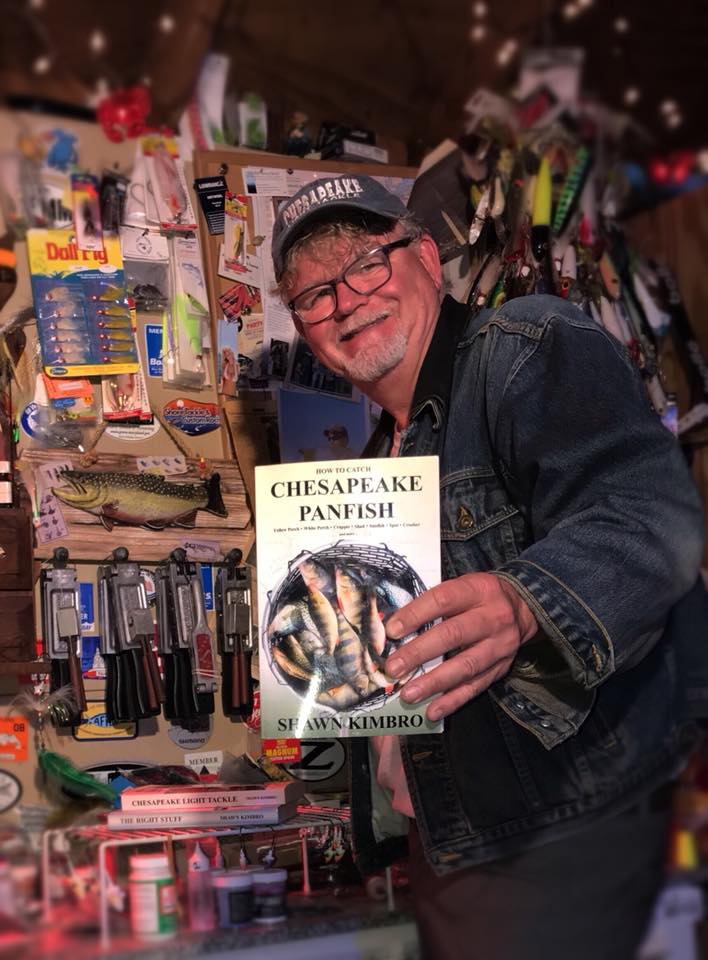 UPDATE 10/7/2018: Books have arrived and we are now shipping!
UPDATE 10/7/2018: Books have arrived and we are now shipping!
Good news! My new book is now available for pre-order. You can select either a limited edition hard cover or a first edition soft cover by clicking on the book pictures on the right side of this page. We expect books to arrive anytime and we will begin shipping as soon as we get them. All pre-ordered books are guaranteed to arrive before the official release date of October 15, 2018. After October 15, books will also be available in tackle shops in both Maryland and Virginia, at Amazon.com, and at other online outlets such as JigTheBay.com. Both the hard cover and soft cover contains 340 pages of which 43 are printed in color. There are over 100 photos and illustrations. Soft covers are $24.95 + shipping and hard covers are $39.95.
From the back cover:
Whether you fish from a boat, kayak, or the bank, there is nothing more fun than catching panfish in the Chesapeake Bay. Digging deep into his bag of panfishing tricks, lifelong angler Shawn Kimbro lays out the best year-round strategies for catching perch, crappie, bluegill, shad, and other species in the tidal waters of the Chesapeake Bay. Featuring the locations of prime fishing spots in Maryland and Virginia along with the history of some of the region’s most popular lures, you’ll find details about the best baits, rigs, lines, rods, reels, and other tackle. Enhanced with entertaining fish tales and illustrated by Eva Nichols’ artful sketches, this book is perfect for both beginning anglers and seasoned panfish pros.
I’m super excited about this new release and very happy to have the opportunity to share my knowledge and research with you my friends and fellow anglers. I hope you enjoy reading it as much as I loved writing it. I look forward to seeing you on the creeks and rivers this fall and winter!
–Shawn
 I quit rockfish. Yes I did. Well, at least for a while. I haven’t fished for striped bass since December 6, 2017. That was the day we landed three huge stripers including a 50-incher just below Poplar Island. It seemed like a good stopping point.
I quit rockfish. Yes I did. Well, at least for a while. I haven’t fished for striped bass since December 6, 2017. That was the day we landed three huge stripers including a 50-incher just below Poplar Island. It seemed like a good stopping point.
Now, don’t get me wrong, I haven’t quit fishing, nor have I given up rockfish for good. In fact, I’ll be back on them next week. I just decided to spend the winter/spring of 2017-2018 fishing for perch, crappie, and shad.
You know what? I’ve had a blast!
I can’t resist the call of the creeks. I dearly love striper fishing, but the hours I’ve put in polishing my rockfish techniques add up to only a fraction of the time I’ve spent in my life-long pursuit of panfish. They are my first love. After over fifty years of fishing, my favorite fish remain bluegill, crappie, perch, and shad.
The longer I live and the more I fish, the more I long for simplicity. To me, panfishing is therapy; a welcome counter to the competitive and frequently fast-paced world of run-and-gun striper fishing. I can stand on the creek bank for hours casting for perch or crappie. It makes me feel like I’m connected to nature, not only as an observer, but as a participant. When I’m panfishing, I never think I’m wasting a minute. In return, panfishing has enhanced my striper fishing skills. The pursuit of perch has made me a better rockfisherman.
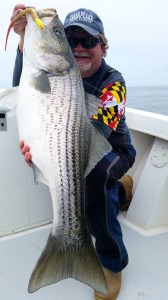 If fishing can be a feast or famine activity, anglers in the Chesapeake Bay region have been eating high on the hog lately. As is typical with April, all good things happen at once. In the past two weeks, I’ve caught shad, white perch, yellow perch, bass, bluegill, crappie, catfish, and stripers. Throw in the walleye and snakeheads my friends are catching, and we’re smack in the middle of a virtual smorgasbord of good fishing. The weather has been spotty, but that hasn’t kept too many anglers off the water. Here’s my report:
If fishing can be a feast or famine activity, anglers in the Chesapeake Bay region have been eating high on the hog lately. As is typical with April, all good things happen at once. In the past two weeks, I’ve caught shad, white perch, yellow perch, bass, bluegill, crappie, catfish, and stripers. Throw in the walleye and snakeheads my friends are catching, and we’re smack in the middle of a virtual smorgasbord of good fishing. The weather has been spotty, but that hasn’t kept too many anglers off the water. Here’s my report:
Yellow Perch: It’s all but over now, but we enjoyed one of the best March ring-perch runs in recent memory. Neds ran big this year and they were plentiful. They were also a little earlier than usual. That made it nice for those of us who were just about going crazy with cabin fever. Most of my fishing was in the Eastern Shore creeks and rivers. I fished Tuckahoe Creek and the Choptank River from Denton up to Red Bridges park. Some days it was one fish after another and on other days it was slow. Yellow perch can be finicky at times. When they are spawning they typically move up the streams in waves. If you aren’t catching, stick around because chances are another wave will move through and you’ll start getting bites again. See my earlier post for more information about the yellow perch run.
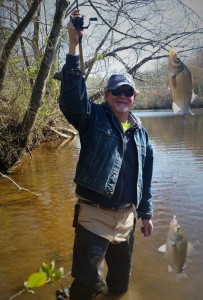 White Perch: I thought the white perch spawn might be over until I got a call from my friend Phil Kerchner last week. He was still lighting up the black backs in the creeks near his place at Wye Mills. I called him last Sunday and we met on the banks of Tuckahoe Creek. It was one pre-spawn white perch after another for a little while. Our best lures were Bust ‘Em Baits stingers and small twister tails rigged in tandem on one-sixteenth-ounce jig heads. As the tide changed, the bite slowed down, but it picked back up before sunset and we took home a very nice stringer. White perch are my favorite fish to eat. I even prefer them over crappie and I think they’re way better than yellow perch. All things in moderation of course, but don’t feel bad about keeping what you want to eat because white perch aren’t threatened and they reproduce prolifically. They will generally hang around the spawning grounds for a little while after they spawn, so I wouldn’t be surprised if we keep catching them in the creeks for a couple of more weeks. After that, they’ll spread out along the shorelines where they can be targeted all summer long.
White Perch: I thought the white perch spawn might be over until I got a call from my friend Phil Kerchner last week. He was still lighting up the black backs in the creeks near his place at Wye Mills. I called him last Sunday and we met on the banks of Tuckahoe Creek. It was one pre-spawn white perch after another for a little while. Our best lures were Bust ‘Em Baits stingers and small twister tails rigged in tandem on one-sixteenth-ounce jig heads. As the tide changed, the bite slowed down, but it picked back up before sunset and we took home a very nice stringer. White perch are my favorite fish to eat. I even prefer them over crappie and I think they’re way better than yellow perch. All things in moderation of course, but don’t feel bad about keeping what you want to eat because white perch aren’t threatened and they reproduce prolifically. They will generally hang around the spawning grounds for a little while after they spawn, so I wouldn’t be surprised if we keep catching them in the creeks for a couple of more weeks. After that, they’ll spread out along the shorelines where they can be targeted all summer long.
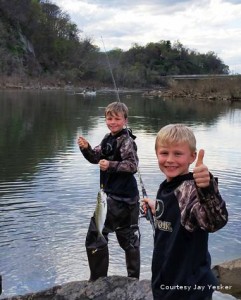 Shad: The shad run is in full swing. I’ve fished the Potomac around Fletcher’s Cove and Chain Bridge twice now and found shad in good numbers both times. Joe Yack is reporting shad in the Susquehanna now as well. The good news is that hickory shad are running big this year. I’ve seen at least two reports of hicks approaching five pounds. Some anglers mistakenly identify bigger hickory shad as white (American) shad because, when they are fully mature, they lose the spots on their shoulders. The key to identifying shad is to look at the lower jaw. If the lower jaw projects beyond the upper one with the mouth closed, it’s a hickory. I typically cast one-quarter or one-eighth ounce shad darts. It pays to experiment when you’re shad fishing because the same colors and techniques that work one day might not work the next. Last week, my fishing buddy Jay Yesker out-fished me by snap-jigging two quarter-ounce darts on eight-pound-test monofilament. (That’s Jay’s boys in the picture.) The fish were taking on the fall. Since my usual spinning rig is eight-pound-test braid with a similar size fluorocarbon leader, I couldn’t duplicate what he was doing because the force of the snap using the stretchless braid would break my leader. You can bet I was rigged with mono the next time I went out, but wouldn’t you know it, on that day the fish wanted a steady fast retrieve! You just don’t know until you go. The shad run should last for several more weeks, so there’s still plenty of time to get in on the action. Read More!
Shad: The shad run is in full swing. I’ve fished the Potomac around Fletcher’s Cove and Chain Bridge twice now and found shad in good numbers both times. Joe Yack is reporting shad in the Susquehanna now as well. The good news is that hickory shad are running big this year. I’ve seen at least two reports of hicks approaching five pounds. Some anglers mistakenly identify bigger hickory shad as white (American) shad because, when they are fully mature, they lose the spots on their shoulders. The key to identifying shad is to look at the lower jaw. If the lower jaw projects beyond the upper one with the mouth closed, it’s a hickory. I typically cast one-quarter or one-eighth ounce shad darts. It pays to experiment when you’re shad fishing because the same colors and techniques that work one day might not work the next. Last week, my fishing buddy Jay Yesker out-fished me by snap-jigging two quarter-ounce darts on eight-pound-test monofilament. (That’s Jay’s boys in the picture.) The fish were taking on the fall. Since my usual spinning rig is eight-pound-test braid with a similar size fluorocarbon leader, I couldn’t duplicate what he was doing because the force of the snap using the stretchless braid would break my leader. You can bet I was rigged with mono the next time I went out, but wouldn’t you know it, on that day the fish wanted a steady fast retrieve! You just don’t know until you go. The shad run should last for several more weeks, so there’s still plenty of time to get in on the action. Read More!
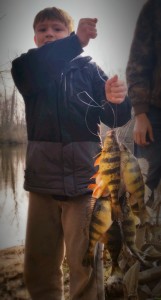 Spring is nature’s way of saying, “Let’s Party!” That’s how the late Robin Williams described it. March may have roared in like a lion, but she’s now lying like a lamb with weeks of warmer weather in the forecast. While the calendar might still say winter, spring, glorious spring has made her eloquent arrival to the snow-weary Mid-Atlantic. The peepers are peeping, the red buds are budding, and yesterday, through the morning fog, I caught a glimpse of an osprey soaring high above Kent Island. There are a lot of reasons why fishermen look forward to the arrival of spring. A big one is the beginning of Daylight Saving Time on March 13 when clocks spring forward to give us one more treasured after-work fishing hour. Another reason is that there are lots of fish around that are relatively easy to catch. Fishing and spring go together like, well like fish and fries.
Spring is nature’s way of saying, “Let’s Party!” That’s how the late Robin Williams described it. March may have roared in like a lion, but she’s now lying like a lamb with weeks of warmer weather in the forecast. While the calendar might still say winter, spring, glorious spring has made her eloquent arrival to the snow-weary Mid-Atlantic. The peepers are peeping, the red buds are budding, and yesterday, through the morning fog, I caught a glimpse of an osprey soaring high above Kent Island. There are a lot of reasons why fishermen look forward to the arrival of spring. A big one is the beginning of Daylight Saving Time on March 13 when clocks spring forward to give us one more treasured after-work fishing hour. Another reason is that there are lots of fish around that are relatively easy to catch. Fishing and spring go together like, well like fish and fries.
Have you noticed how all the fast food restaurants put their fish sandwiches on sale this time of year? I believe humans are hard-wired to crave fish in the spring. It’s been right there in our DNA since the first hunter-gatherers wandered away from their warm winter hearths to find springtime streams teeming with spawning fish. For many fishermen, the urge is so strong it’s nearly impossible to stay away from the water in March and April. This is the time of year when fish are easiest to catch, and the time when we most want to eat them.
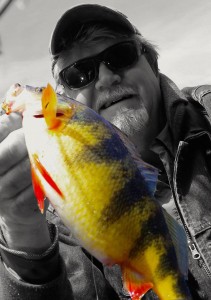 I’m not one to turn down the bounty of fresh fish. While I release many of the fish I catch, I can’t resist bringing home an occasional stringer for the table. I’m a big fan of eating locally produced fruits, meats, and vegetables. We get our honey from local hives, our beef from a nearby herd, and many of our vegetables from our garden. Since we live on an island in the Chesapeake Bay, it just comes naturally to eat fish from the waters around us. Unfortunately, those waters are very polluted, so there are strict consumption advisories about fish caught in this area. In fact, officials in Washington DC recently advised no consumption of rockfish caught in the District. I will no longer serve my family striped bass over 30 inches long from anywhere in the Bay because of the build up of toxins. It’s a personal decision, but one that I’m serious about. My children and grandchildren aren’t old enough to make choices for themselves about what is healthy. They’re too young for me to take a chance on poisoning them. Read More!
I’m not one to turn down the bounty of fresh fish. While I release many of the fish I catch, I can’t resist bringing home an occasional stringer for the table. I’m a big fan of eating locally produced fruits, meats, and vegetables. We get our honey from local hives, our beef from a nearby herd, and many of our vegetables from our garden. Since we live on an island in the Chesapeake Bay, it just comes naturally to eat fish from the waters around us. Unfortunately, those waters are very polluted, so there are strict consumption advisories about fish caught in this area. In fact, officials in Washington DC recently advised no consumption of rockfish caught in the District. I will no longer serve my family striped bass over 30 inches long from anywhere in the Bay because of the build up of toxins. It’s a personal decision, but one that I’m serious about. My children and grandchildren aren’t old enough to make choices for themselves about what is healthy. They’re too young for me to take a chance on poisoning them. Read More!
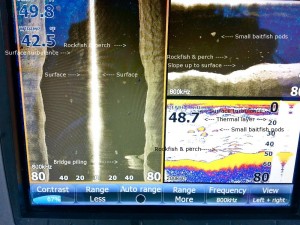 We interrupt this conservation blog with a fishing report. Nah, it’s the other way around. Chesapeake Light Tackle will always be first and foremost a fishing-report website. Well, fishing reports along with some occasional good advice about gear and techniques. Don’t worry – I won’t be lightening up on Maryland DNR’s bad decision to increase rockfish harvest by 14 percent in the face of impending cuts, but I wanted to let you know that I have been lighting up some local fishing spots lately. It’s the holidays, and the weather hasn’t been great, but there are still some fish to be caught for those who are willing to brave the elements and cast for them. The warm water discharges have been hit-and-miss lately. Most of the anglers who have visited them have been disappointed, but once in a while, I hear of a good fish or two being caught. The same goes for the deep holes at the mouths of the rivers and also for my go-to-winter honey hole: Light Tackle University (“LTU”). Read More!
We interrupt this conservation blog with a fishing report. Nah, it’s the other way around. Chesapeake Light Tackle will always be first and foremost a fishing-report website. Well, fishing reports along with some occasional good advice about gear and techniques. Don’t worry – I won’t be lightening up on Maryland DNR’s bad decision to increase rockfish harvest by 14 percent in the face of impending cuts, but I wanted to let you know that I have been lighting up some local fishing spots lately. It’s the holidays, and the weather hasn’t been great, but there are still some fish to be caught for those who are willing to brave the elements and cast for them. The warm water discharges have been hit-and-miss lately. Most of the anglers who have visited them have been disappointed, but once in a while, I hear of a good fish or two being caught. The same goes for the deep holes at the mouths of the rivers and also for my go-to-winter honey hole: Light Tackle University (“LTU”). Read More!


